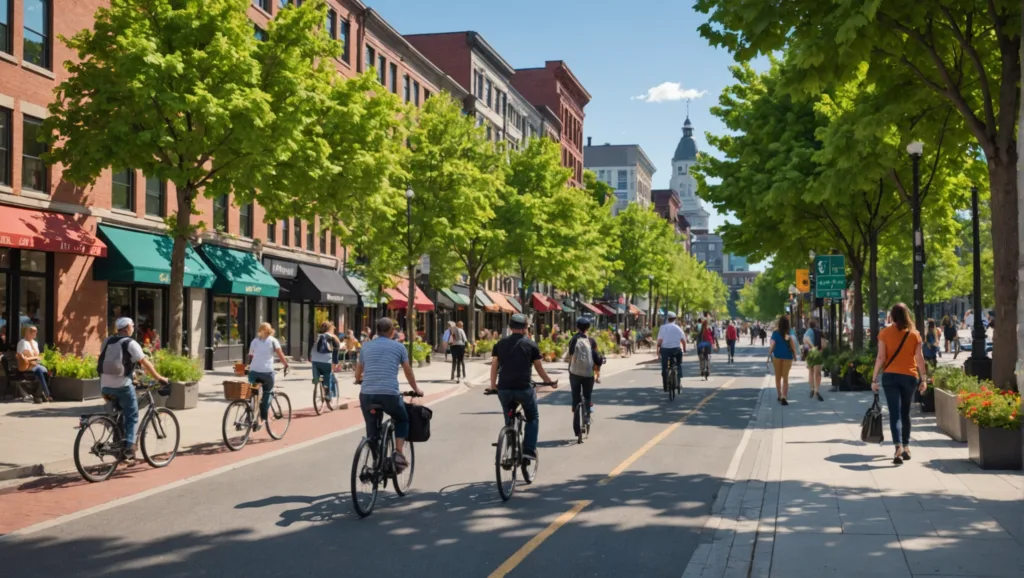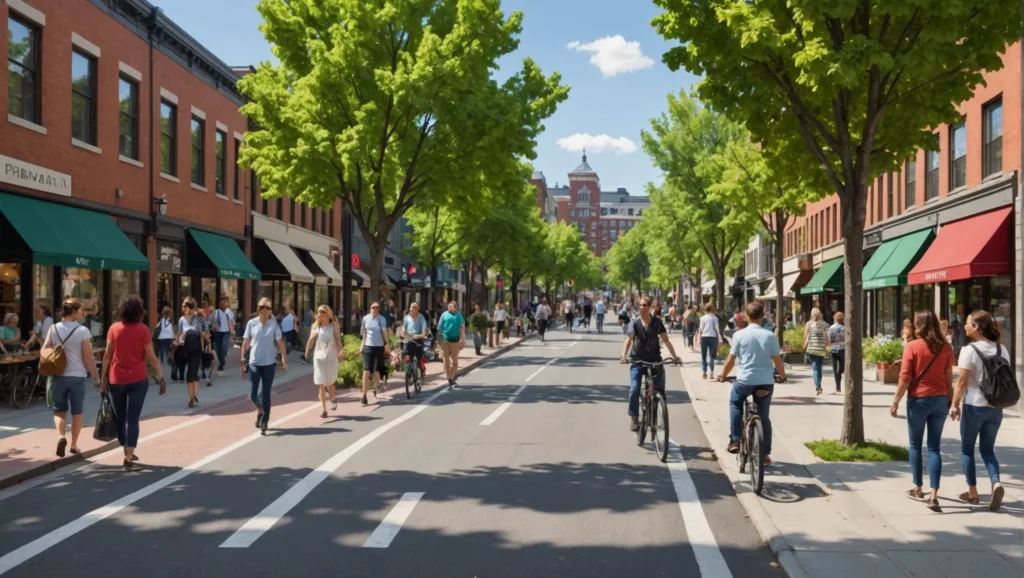Urban Design Strategies for Creating Pedestrian-Friendly Environments
Creating pedestrian-friendly environments in urban settings is a critical consideration in urban design strategies. The primary aim is to shift focus from car-centric designs towards more comprehensive urban layouts that facilitate and encourage people to walk. The benefits of walkable cities are manifold, extending to improved public health, decreased car use and traffic, environmental sustainability, and enhanced quality of life for urban residents. These pedestrian-friendly environments manifest as walkable neighborhoods characterized by short block lengths, ample street trees, and engaging streetscape designs. They provide safe and convenient places for people to walk, work, and spend time.
The challenge for urban designers is finding the right balance that caters to the needs of various modes of transportation while increasing walkability. For instance, city streets should accommodate car traffic without compromising the pedestrian environment. This can be achieved through specific approaches in land use, such as discouraging urban sprawl and promoting diversity and density in built environments. Other strategies include creating a sense of enclosure to enhance pedestrians’ perception of safety, defining priority streets that favor pedestrian use, and developing public transport systems that effectively connect less walkable areas.

By ensuring that distances that cannot be comfortably traveled by foot are well-serviced by reliable public transportation, cities can ensure that life without a car is not only possible but also preferable. These urban design strategies ultimately contribute towards the creation of sustainable cities, where walkable and bikeable areas are more than merely an option, but rather, a norm.
The Role of Accessibility in Producing Walkable Cities
The role of accessibility in producing walkable cities is instrumental, and it inevitably revolves around the concept of pedestrian-friendly infrastructure. The blueprint for walkable communities encompasses a range of elements designed to promote and facilitate walking as a viable mode of transport. This framework typically includes attributes such as ample and safe pedestrian access, a variety of places to walk, and policies conducive to encouraging pedestrian engagement. Proactive transportation planning should prioritize walkability, but it’s crucial to understand that walkability does not necessarily translate to the exclusion of cars on the road. Instead, cities need to focus on cultivating an environment that embraces all modes of transport while placing extra emphasis on nurturing healthy streets for walking.
Walkability not only reduces the dependency on vehicular transport and in turn mitigates carbon footprints but also fosters social interaction and community ties which makes people want to spend time in such spots. For people to not just want to walk to work but readily engage in leisure walking, elements such as proximity, cohesiveness, and comfort play a key role. Steps made by walking in such environments invariably lead to higher physical activity, boosting public health outcomes, reducing medical costs, and enhancing quality of life. However, this urban virtue may potentially lead to discussions of gentrification, and it’s important for advocates for more walkable cities to ensure that plans to expand accessibility don’t inadvertently create social stratification. To increase walking in cities, the process has to be gradual, accommodating, and inclusive so that people will walk and enjoy the journey as much as the destination.
Incorporating Transit and Zoning Policies to Make Cities More Walkable
In addressing the objective of creating more pedestrian-friendly cities, it is essential to incorporate efficient transit and progressive zoning policies. Not only do these play a significant role in fostering urban development, they can radically transform cities making them more accessible and safer for pedestrians. A city that strategically interweaves public transit systems and zoning laws can incrementally reduce dependency on private vehicles. Concentrating on shaping city structures that push for more walking, cycling, and public transit use directly benefits the city’s ecological footprint and the physical health of the community. Proactive zoning policies can promote designs for mixed-use development where residential spaces coexist with stores, workplaces, and amenities, thereby reducing travel distances. Similarly, integrating transit policies into city planning presents a holistic approach to urban mobility.

This may include a range of tactics:
- Prioritizing pedestrian and cycle lanes in city plans.
- Imposing speed limits in highly populated areas.
- Increasing the frequency of public conveyances during peak hours.
- Establishing accessible transit stations for seamless connectivity between various modes of transport.
These strategies can contribute to creating a city infrastructure that is not only pedestrian-friendly but also vibrant, diverse, and environmentally sustainable.
Realizing the “Complete Streets” Vision: Prioritizing Streets for Pedestrians
In the quest to realize the “Complete Streets” vision, prioritizing streets for pedestrians is a crucial step towards creating more inclusive and sustainable urban environments. The concept of Complete Streets is rooted in the idea of designing and operating streets to enable safe, convenient, and comfortable travel for users of all ages and abilities, regardless of their mode of transportation. This vision is particularly transformative when it comes to pedestrian priority, as it challenges the conventional car-centric urban planning model. By focusing on pedestrians, Complete Streets encourage the development of urban spaces that are not only safer and more navigable for foot traffic but also more vibrant and engaging. Key strategies in this paradigm shift include widening sidewalks, adding crosswalks, reducing vehicle speed limits, and integrating green spaces, all of which enhance the pedestrian experience. These changes not only improve the aesthetic appeal of urban spaces but also promote physical activity, reduce traffic congestion, and improve air quality. As cities globally embrace this vision, they are not just redesigning streets; they are reshaping their communities into healthier, more connected, and resilient spaces.
The Benefits of Walkability in Urbanism: Promoting Safe and Comfortable Pedestrian Travel
The concept of walkability, which refers to the ease with which residents can navigate their neighborhood on foot, plays a pivotal role in urban planning. It denotes a stride towards sustainable and greener urban development, suggesting a reduced dependency on cars and other motor vehicles. Walkability, sprouting out from the foundations of urban design, is a core element of ‘new urbanism’ that roots for the pedestrian-friendly and mixed-use zone with an emphasis on people over machines. It contributes to the making of pedestrian-friendly urban areas that prop up walking and cycling as primary modes of transportation. Walkable cities encompass pedestrian-friendly design elements such as complete streets, shorter block lengths, sidewalk accessibility, and the incorporation of various modes of transportation, intermixing areas of work, living, and leisure for residents.
Urban planners endeavor to foster urban centers and neighborhoods with high walkability, striving to strike the right balance between comfort and accessibility. The concept of creating walkable cities upholds characteristics like:
- Close proximity to amenities, reducing the need for vehicular travel.
- Street design that prioritizes pedestrian safety, encouraging walking over driving.
- Green spaces and public spaces, increasing the attraction and utility of a neighborhood.
- Adequate public transportation and transit corridors to decrease dependency on personal motor vehicles.
- Well thought-out urban density for efficient land use.
These features not only promote people’s willingness to walk, but also open opportunities for walking and biking as a practical form of transportation. Additionally, the urban development that prioritizes walkability significantly also contributes to lowering vehicle emissions, thereby leading to sustainable and environmentally friendly cities. Furthermore, non-physical elements like reducing parking requirements and supporting accessory dwelling units in suburbs to increase urban density offer multifaceted benefits, underscoring the profound social benefits of walkability.
The mission of urban planners and city councils in American cities and many cities worldwide focuses on transforming cities to make them more walkable, prioritizing pedestrian infrastructure and safety. Making a city walkable is an evolving process, adjusting to changes in urban residents’ needs and patterns, reflecting the multifaceted and dynamic nature of city life.
Conclusion
In the dynamic realm of urban planning, the emphasis on walkability stands as a testament to our evolving understanding of what constitutes a vibrant, sustainable, and livable city. The infusion of pedestrian-friendly initiatives and the prioritization of streets for pedestrians are not just about creating spaces for walking; they are about cultivating environments that resonate with human needs and ecological balance. From integrating transit and zoning policies to harnessing the ethos of “Complete Streets,” cities worldwide are embarking on transformative journeys. These endeavors champion safe, convenient, and enjoyable pedestrian travel, underpinning a larger vision of urbanism that harmonizes human interaction, environmental responsibility, and community well-being. In essence, as we tread further into the 21st century, the concept of walkability in urban design crystallizes as a beacon guiding us toward more inclusive, healthier, and interconnected urban futures.
FAQs
Q1: What makes a city walkable?
A1: A city is considered walkable when it has well-designed, safe, and accessible pedestrian infrastructure, such as sidewalks, crosswalks, traffic calming measures, proximity to amenities, green spaces, and a mix of residential, commercial, and leisure spaces within walking distance.
Q2: Why is walkability important in urban planning?
A2: Walkability is crucial because it promotes public health, and environmental sustainability, reduces reliance on vehicles, fosters social interaction, and improves the overall quality of urban life.
Q3: How can urban design strategies create pedestrian-friendly environments?
A3: Urban design strategies can create pedestrian-friendly environments by implementing “Complete Streets” principles, prioritizing pedestrian access, enhancing connectivity, and ensuring safe and comfortable walking conditions.
Q4: What are the benefits of prioritizing streets for pedestrians?
A4: Prioritizing streets for pedestrians leads to safer and more engaging urban spaces, promotes physical activity, reduces traffic congestion, improves air quality, and enhances the aesthetic appeal of cities.
Q5: Can walkable cities still accommodate vehicles?
A5: Yes, walkable cities can accommodate vehicles by balancing the needs of various modes of transportation, using smart urban planning to ensure coexistence, and prioritizing pedestrian safety and comfort.
Q6: How does walkability impact the environment?
A6: Walkability positively impacts the environment by reducing vehicular emissions, promoting sustainable land use, and encouraging green urban development.
Q7: What role does public transportation play in making cities more walkable?
A7: Public transportation plays a significant role by providing accessible and efficient alternatives to private vehicles, linking less walkable areas, and reducing overall reliance on cars in urban settings.

Nina Jerkovic
Meet Nina Jerkovic, our expert on all things green and sustainable. With a keen eye for eco-friendly living, Nina shares practical tips and insights to help you navigate the world of sustainable choices. Join her on a mission to create a healthier planet through mindful living.


 Promoting Active Transportation | Encouraging Walking As A Daily Habit
Promoting Active Transportation | Encouraging Walking As A Daily Habit
